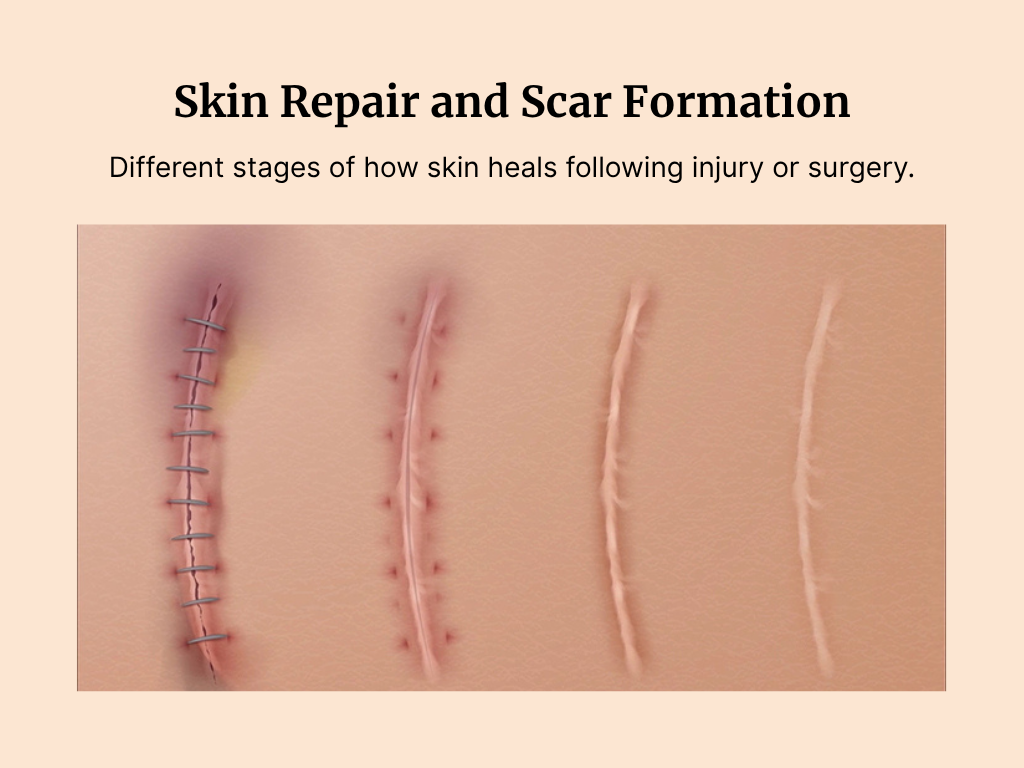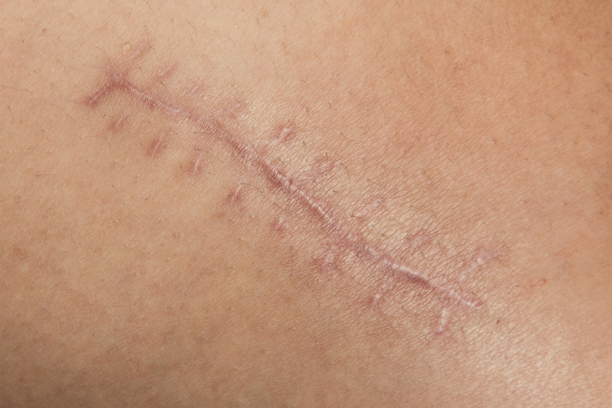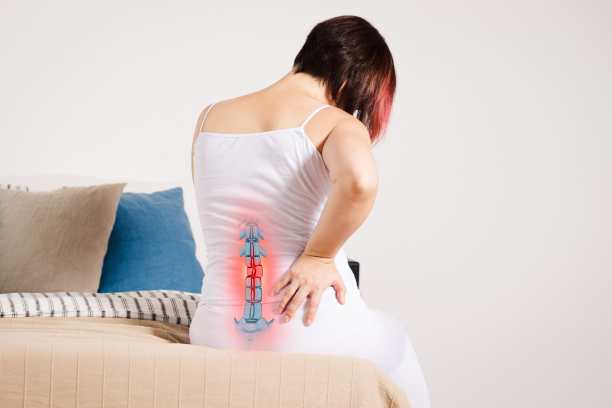Total Knee Replacement (TKR) can offer significant relief from knee osteoarthritis by reducing chronic joint pain and improving mobility and quality of life. However, many patients overlook that surgical recovery is not just about regaining movement. It is also about feeling comfortable and confident in your skin. Scarring and pigmentation can affect self-esteem, daily comfort, and even the long-term success of your new knee.
For many Indian patients, particularly those with darker skin tones (higher melanin levels), the visible scarring that follows surgery can become a long-term concern. This is further aggravated by intense sun exposure, limited awareness of post-surgery skin care, and poor scar management protocols, resulting in the scar becoming darker, raised, and more pronounced.
While some clinicians may dismiss post-surgical scarring as a purely cosmetic issue, emerging research suggests otherwise. A 2023 study found that excessive scar tissue can lead to pain, reduced flexibility, and limited range of motion (ROM), which may compromise the overall outcome of the knee replacement.
A scar is a natural part of the healing process, but that does not mean it should be left unmanaged. With the right care, its appearance can be minimised and skin recovery supported, particularly when adapted to the Indian context.
We have created a simple six-step guide to help you care for your knee scar after TKR. However, before we outline the protocol, it is important to understand why scars form in the first place.
Scar tissue develops as the body repairs skin and deeper tissues following injury or surgery. In the case of TKR, the 4-6 inch incision and internal surgical trauma prompt the body to produce collagen to seal the wound. This collagen is often laid down in a thicker, more disorganised structure, resulting in a scar that is both visible and, in some cases, might restrict functional mobility.

Here are some key factors that are scientifically proven to delay scar recovery:
- Infection or poor wound care in the early healing phase (0-3 weeks)
- Excessive sun and UV exposure, especially in darker skin types
- Excessive stretching or pressure on the healing incision
- Skipping physiotherapy, which affects both internal healing and external skin elasticity
- Poor nutrition, especially low protein and vitamin C intake
Here is a simple, step-by-step guide on how to care for your scar so that it heals properly.
Step 1: Let the Wound Heal Naturally (0–3 weeks)
In the first few weeks post-surgery, the priority is wound healing and infection prevention.
Do not apply any oils, creams, or powders until the stitches or staples are removed and your doctor confirms the incision has closed. Avoid touching, scrubbing, or stretching the area. Wear loose-fitting clothing and keep the area dry. In humid climates, moisture and sweat can increase the risk of infection, so hygiene is essential.
Step 2: Sun Protection is Essential (3–12 weeks)
This is the most neglected step in India. Ultraviolet (UV) radiation worsens scarring, especially in people with brown or darker skin, by causing hyperpigmentation and darkened scars. If your knee is exposed during daily activities, always cover it with a soft cloth or cotton sleeve. Apply a broad-spectrum sunscreen (SPF 30 or higher) even when indoors, as UV light can penetrate through windows. Avoid exposing the healing scar to direct sunlight, particularly between 10 am and 4 pm.
Step 3: Start Silicone Gel Scar Therapy (Week 4 onward)
Once your doctor confirms that the wound has fully healed, you can begin using silicone-based products, which are considered the gold standard in scar therapy. Silicone gels or sheets help to flatten, lighten, and soften the scar over time. Use them daily for two to three months, especially if you notice thickening or darkening. These products are safe and widely available in Indian pharmacies under brands such as ScarEnd, Mederma, and Dermatix. <<should we mention these products? Is it a good practice>>
Step 4: Gentle Massage with Moisturiser (Week 5 onward)
Daily gentle massage helps to improve blood flow, break down excess collagen, and reduce tightness around the scar. Use a non-irritating moisturiser such as coconut oil, aloe vera gel, or a fragrance-free lotion. Massage the scar for 5-10 minutes twice a day, using circular motions. This approach is particularly beneficial in Indian skin types, which are more prone to fibrosis and pigmentation if neglected.
Step 5: Do Not Skip Physiotherapy – It Helps Your Skin Too
Many people assume physiotherapy is only for muscle and joint recovery. However, consistent knee movement through guided physiotherapy also prevents excessive internal scarring (adhesions), improves circulation, and reduces stiffness around the skin. Poor adherence to rehabilitation plans can cause the scar to pull or become raised over time. Follow your physiotherapist’s plan closely to ensure the best possible outcome, both functionally and cosmetically.
Step 6: Support Healing with the Right Nutrition (Throughout Recovery)
Healing from surgery is not just about rest and physiotherapy. What you eat plays a direct role in how well your scar heals. Among older adults or vegetarians, nutritional gaps can slow down recovery and increase the risk of dark, raised, or stubborn scars. This is particularly common in India.
Protein is the building block of collagen, the key material the body uses to repair skin. Without adequate protein, your body cannot rebuild tissue effectively. Vitamin C supports collagen production and prevents excessive pigmentation. Zinc plays a crucial role in skin repair and wound closure. A lack of any of these nutrients can delay healing and worsen scarring.
Keep in mind: Some foods that support scar healing may aggravate joint pain in people with arthritis. If you or your loved one has osteoarthritis, it is best to avoid or limit dairy, peanuts, meats, and high-sugar foods. Always monitor how your body responds and consult a doctor if you are unsure.
Some arthritis-friendly Indian foods that can aid scar recovery:
- Protein-rich foods: Lentils (dal), chickpeas, tofu, and boiled eggs help rebuild tissue. Consider adding a plant-based or egg-based protein supplement if your daily intake is low, especially in the first six to eight weeks post-surgery.
- Zinc-rich foods: Roasted pumpkin seeds, sunflower seeds, and whole grains aid skin repair
- Vitamin C sources: Amla, guava, lemon, oranges, and capsicum support collagen synthesis and reduce pigmentation
- Healthy fats: Almonds, walnuts, and small amounts of cold-pressed oils support skin regeneration
- Iron-rich foods: Green leafy vegetables (like methi), soaked raisins, and legumes improve oxygen supply to healing tissues
Scarring after TKR is natural, but its severity can be managed. In India, where darker skin tones are more prone to pigmentation and sunlight is intense year-round, the risk of poor scar outcomes is higher. This five-step plan provides a simple, practical path to minimising scarring and feeling more confident in your recovery. Early care, sun protection, and consistency are essential.
References
- https://pubmed.ncbi.nlm.nih.gov/38079496/
- J Arthroplasty. 2017 Aug;32(8):2604-2611. doi: 10.1016/j.arth.2017.02.005. Epub 2017 Feb 14.
This article is reviewed by Dr. Anurag Gupta, a gold medalist in MPT-Sports Physiotherapy, has worked with elite international and national athletes across football, tennis, and badminton. His clientele includes Srikanth Kidambi (#1 Men’s Badminton Player, Arjuna Awardee, Padma Shri) and Hendra Setiawan (Olympic Gold Medalist, 4x World #1 in Men’s Badminton).
Beyond athletes, Dr. Gupta is the preferred physiotherapist for top founders, including Vivek Gupta (Licious), Rishabh Telang (Cult.fit), and Arjun Chaudhary (former MFine), helping them recover from musculoskeletal issues efficiently.










